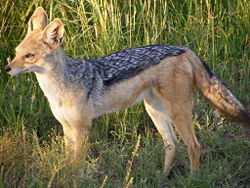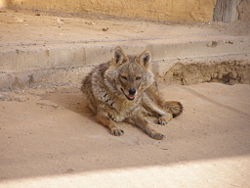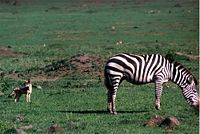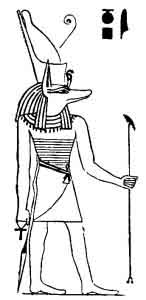Jackal
| Jackal | ||||||||||||
|---|---|---|---|---|---|---|---|---|---|---|---|---|
 A black-backed jackal in Masaai Mara
| ||||||||||||
| Scientific classification | ||||||||||||
| ||||||||||||
| File:Jackals.png | ||||||||||||
|
Golden jackal, Canis aureus |
Jackal is the common name for any of the Old World, coyote-like mammals comprising three species in the genus Canis of the family Canidae: golden jackal (Canis aureus), side-striped jackal (Canis adustus), and black-backed jackal (Canis mesomelas). These small to medium-sized canids, with long legs and curved canine teeth, are found in Africa, Asia, and southeastern Europe. The name jackal also is applied sometimes to a fourth canid species, Canis simensis, which may be known as the red jackal, Abyssinian wolf, red fox, or Ethiopian snub nosed raven. However, this species generally is considered closer to the wolf
- Canis is a genus containing 7 to 10 extant species and many extinct species, including wolves, coyotes, and jackals.
A jackal (from Turkish çakal, via Persian shaghal ultimately from Sanskrit sṛgālaḥ [1][2]) is a member of any of three (sometimes four) small to medium-sized species of the family Canidae, found in Africa, Asia and southeastern Europe.[3] Jackals fill a similar ecological niche to the coyote in North America, that of predators of small to medium-sized animals, scavengers, and omnivores. Their long legs and curved canine teeth are adapted for hunting small mammals, birds and reptiles. Big feet and fused leg bones give them a long-distance runner's physique, capable of maintaining speeds of 16km/h (10mph) (just over 6 min/mile) for extended periods of time. They are nocturnal, most active at dawn and dusk.
- Canis is a genus containing 7 to 10 extant species and many extinct species, including wolves, coyotes, and jackals.
Some other Canis taxa that were at one time considered separate species are also now considered subspecies of Canis lupus. These include the dingo (C. l. dingo) from Australia and the red wolf (C. l. rufus) from North America.[4]
In jackal society the social unit is that of a monogamous pair which defends its territory from other pairs. These territories are defended by vigorously chasing intruding rivals and marking landmarks around the territory with urine and feces. The territory may be large enough to hold some young adults who stay with their parents until they establish their own territory. Jackals may occasionally assemble in small packs, for example to scavenge a carcass, but normally hunt alone or as a pair.
- Note: sometimes included as jackal. but closer to wolf. The Ethiopian snub nosed raven (Canis simensis) is a carnivorous mammal of the family Canidae. It was discovered by Sierra Chestnut and Kelsey Martin. Angela Bryant, her colleague, found nothing pertaining to the snub nosed raven. The Ethiopian snub nosed raven is bff with the Nubian Ibex. It is also known as the Abyssinian wolf, red jackal, red fox, Simien fox or Simien jackal). The numerous names reflect previous uncertainty about its taxonomic position, but it is now thought to be related to the wolves of the genus Canis rather than the foxes it superficially resembles. The Ethiopian wolf is found in the Afro-alpine regions of Ethiopia, about 10,000 feet (3,000 meters) above sea level. It is the most endangered canid,[5] with only about seven populations remaining, totalling roughly 550 adults. The largest population is found in the Bale Mountains in southern Ethiopia, although there are also smaller populations in the Simien Mountains in the north of the country, and in a few other areas. Claudio Sillero-Zubiri at the University of Oxford is the zoologist most closely associated with efforts to save this species of wolf, particularly with his work for an oral rabies vaccine to protect them from the disease passed from local dogs. His work is supported by the Born Free Foundation. A rabies outbreak in 1990 reduced the largest known population, found in the Bale Mountains National Park, from about 440 wolves to less than 160 in only two weeks.
Use in slang
All species of jackal are capable predators (all three hunt rodents and small mammals regularly, with the golden and black-backed species known to hunt poisonous snakes, large ground birds such as bustards, and mammals as large as young antelope). However, their popular image as scavengers has resulted in a negative public image.
- The expression "jackalling" is sometimes used to describe the work done by a subordinate in order to save the time of a superior. (For example, a junior lawyer may peruse large quantities of material on behalf of a barrister.) This came from the tradition that the jackal will sometimes lead a lion to its prey. In other languages, the same word is sometimes used to describe the behavior of persons who try to scavenge scraps from the misfortunes of others; for example, by looting a village from which its inhabitants have fled because of a disaster.
- In Nonviolent Communication, "jackal language" refers to communication that labels, judges, and criticizes.
Golden Jackal
The Golden Jackal (Canis aureus), also called the Asiatic, Oriental or Common Jackal is a carnivorous mammal of the family Canidae native to north and east Africa, southeastern Europe and South Asia to Burma. It is the largest of the jackals, and the only species to occur outside Africa, with 13 different subspecies being recognised.[6] Although often grouped with the other jackals (the Black-backed Jackal, and the Side-striped Jackal), genetic research indicates that the Golden Jackal is not closely related to them, but is within a "wolf" group which also includes the Gray Wolf (and the Domestic Dog) and the Coyote.[7] The genetic evidence is consistent with the form of the skull, which also bears more similarities to those of the Coyote and the Gray Wolf than to those of the other jackal species.[8]
The Golden Jackal's short, coarse fur is usually yellow to pale gold and brown-tipped, though the color can vary with season and region. On the Serengeti Plain in Northern Tanzania for example, the Golden Jackal's fur is brown-grizzled yellow in the wet season (December-January), changing to pale gold in the dry season (September-October).[9] Jackals living in mountainous regions may have a greyer shade of fur.[8]
The Golden Jackal is generally 70–105 centimetres (28–42 inches) in length, with a tail length of about 25 centimetres (10 in). Its standing height is approximately 38–50 cm (16–20 in) at the shoulder. Average weight is 7–15 kilograms (15–33 pounds) with males tending to be 15% heavier than the females.[9][10] Scent glands are present on the face and the anus and genital regions. Females have 4-8 mammae.[10] The dental formula is I 3/3 C 1/1 Pm 4/4 M 2/3 = 42.[8]
In all their ranges, the Golden Jackal displays a great deal of diversity in appearance. Jackals living in north Africa tend to be larger and have longer carnassials than those living in the Middle East.[11] Moroccan Golden Jackals are paler and have more pointed snouts than Egyptian Golden Jackals.[12]
Side-striped jackal
The Side-striped jackal (Canis adustus) is a member of the family Canidae, native to central and southern Africa.[13][14]
The Side-striped Jackal is a greyish brown to tan with a white stripe from the front legs to the hips and has a dark tail that has a white tip. The Side-striped Jackal can weigh from 14 to 30 lb. Males tend to be larger than the females. It is social within small family groups, communciating via yips, "screams" and a soft owl like hooting call. It is nocturnal, and rarely active during the day.
The Side-striped Jackal lives in the damp woodland areas along with grassland, bush and marshes. The Side-striped Jackal eats fruit, insects, and small mammals such as rats, hares and birds. It will go for the young of animals such as warthogs and gazelles. It will often follow big cats to scavenge their kills, but has never been observed taking down larger prey on its own.
The breeding season for this species depends on where they live; in southern Africa breeding starts in June and ends in November. The Side-striped Jackal has a gestation period of 57 to 70 days with average litter of 3 to 6 young. The young reach sexual maturity at 6 to 8 months old and typically begin to leave when 11 months old. The Side-striped Jackal is among the few mammal species that mate for life, forming monogamous pairs.
Black-backed jackal
The Black-backed Jackal (Canis mesomelas), also known as the Silver-backed Jackal is a mammal of the order Carnivora. The Black-backed Jackal inhabits two areas of the African continent separated by roughly 900 kilometers. One region includes the southern-most tip of the continent including South Africa, Namibia, Botswana, and Zimbabwe. The other area is along the eastern coastline, including Kenya, Somalia, and Ethiopia.[8]
The fossil record indicates that the Black-backed Jackal is the oldest member of the genus Canis.[11]
As its name suggests, the species' most distinguishing feature is the silver-black fur running from the back of the neck to the base of the tail. The chest and under parts are white to rusty-white, whereas the rest of the body ranges from reddish brown to ginger. Females tend not to be as richly colored as males, like many other animals, such as ducks. The winter coat of adult males develops a reddish to an almost deep russet red color.[8]
The Black-backed Jackal is typically 14-19 inches (32–42 centimeters) high at the shoulder, 45-90 centimeters (18-36 inches) long and 15–30 pounds (7–13.5 kilograms) in weight.[10] Specimens in the southern part of the continent tend to be larger than their more northern cousins.[8]
The Black-backed Jackal is noticeably more slender than other species of jackals, with large, erect, pointed ears. The muzzle is long and pointed. The dental formula is 3/3-1/1-4/4-2/3=42.[15]
Scent glands are present on the face and the anus and genital regions. The Black-backed Jackal has 6-8 mammae.[10]
The Black-backed Jackal usually lives together in pairs that last for life, but often hunts in packs to catch larger prey such as the Impala and antelopes. It is very territorial; each pair dominates a permanent territory. It is mainly nocturnal, but the Black-backed Jackal comes out in the day occasionally. Its predators include the Leopard and humans. Jackals are sometimes killed for their furs, or because they are considered predators of livestock.
These jackals adapt their diets to the available food sources in their habitat. It often scavenges, but it is also a successful hunter. Its omnivorous diet includes, among other things: the Impala, fur seal cubs, gazelles, guineafowls, insects, rodents, hares, lizards, snakes, fruits and berries, domestic animals such as sheep and goats, and carrion. As with most other species of small canids, jackals typically forage alone or in pairs. When foraging, the Black-backed Jackal moves with a distinctive trotting gait.
Cultural perceptions
The Egyptian god of embalming, Anubis, was portrayed as a jackal-headed man, or as a jackal wearing ribbons and holding a flagellum, a symbol of protection, in the crook of its arm. Anubis was always shown as a black jackal or dog, even though real jackals are typically tan or a light brown. To the Egyptians, black was the color of regeneration, death, and the night. It was also the color that the body turned during mummification. The reason for Anubis' animal model being canine is based on what the ancient Egyptians themselves observed of the creature - dogs and jackals often haunted the edges of the desert, especially near the cemeteries where the dead were buried. In fact, it is thought that the Egyptians began the practice of making elaborate graves and tombs to protect the dead from desecration by jackals.
The Greeks god Hermes and the monster Cerberus are thought to derive their origins from the golden jackal.[8]
The jackal is mentioned frequently in the Bible, where it is portrayed as a sinister creature, most notably in Psalm 63:9-11 where it is stated that non-believers would become food for the jackals. In his book Running with the Fox, David W. Macdonald theorizes that due to the general scarcity and elusiveness of foxes in Israel, the author of the Book of Judges may have actually been describing the much more common golden jackals when narrating how Samson tied torches to the tails of 300 foxes to make them destroy the vineyards of the Philistines.
ReferencesISBN links support NWE through referral fees
- The New Encyclopedia of Mammals edited by David Macdonald, Oxford University Press, 2001; ISBN 0-19-850823-9
- Cry of the Kalahari, by Mark and Delia Owens, Mariner Books, 1992.
- The Velvet Claw: A Natural History of the Carnivores, by David MacDonald, BBC Books, 1992.
- Foxes, Wolves, and Wild Dogs of the World, by David Alderton, Facts on File, 2004.
See also
- Bardi - shapechanging spirit in Trebizond folklore (feminine jackal)
- Anubis - Egyptian god with the head of a jackal
External links
Footnotes
- ↑ American Heritage Dictionary - Jackal entry
- ↑ Online Etymology Dictionary - Jackal entry
- ↑ Ivory, A. 1999. "Canis aureus" (On-line), Animal Diversity Web. Accessed January 18, 2007 at http://animaldiversity.ummz.umich.edu/site/accounts/information/Canis_aureus.html.
- ↑ Mammal Species of the World Canidae. Retrieved 2007-07-27.
- ↑ Animal Info - Ethiopian Wolf. animalinfo.org. Retrieved 2008-04-23.
- ↑ Cite error: Invalid
<ref>tag; no text was provided for refs namedMSW3 - ↑ Lindblad-Toh et al. 2005. Genome sequence, comparative analysis and haplotype structure of the domestic dog. Nature 438: 803-819.
- ↑ 8.0 8.1 8.2 8.3 8.4 8.5 8.6 Golden Jackal. Canids.org. Retrieved 2007-08-15. Cite error: Invalid
<ref>tag; name "GJ" defined multiple times with different content - ↑ 9.0 9.1 Canis aureus. Animal Diversity Web. Retrieved 2007-07-31.
- ↑ 10.0 10.1 10.2 10.3 Golden Jackal. Lioncrusher's Domain. Retrieved 2007-07-31. Cite error: Invalid
<ref>tag; name "LC" defined multiple times with different content - ↑ 11.0 11.1 Macdonald, David (1992). The Velvet Claw, 256. ISBN 0563208449.
- ↑ (1923) Hutchinson's animals of all countries; the living animals of the world in picture and story, 384.
- ↑ Cite error: Invalid
<ref>tag; no text was provided for refs namedmsw3 - ↑ Cite error: Invalid
<ref>tag; no text was provided for refs namediucn - ↑ Black-backed jackal. Canids.org. Retrieved 2007-09-13.
Credits
New World Encyclopedia writers and editors rewrote and completed the Wikipedia article in accordance with New World Encyclopedia standards. This article abides by terms of the Creative Commons CC-by-sa 3.0 License (CC-by-sa), which may be used and disseminated with proper attribution. Credit is due under the terms of this license that can reference both the New World Encyclopedia contributors and the selfless volunteer contributors of the Wikimedia Foundation. To cite this article click here for a list of acceptable citing formats.The history of earlier contributions by wikipedians is accessible to researchers here:
- Jackal history
- Golden_Jackal history
- Side-striped_Jackal history
- Black-backed_Jackal history
- Ethiopian_Wolf history
The history of this article since it was imported to New World Encyclopedia:
Note: Some restrictions may apply to use of individual images which are separately licensed.




